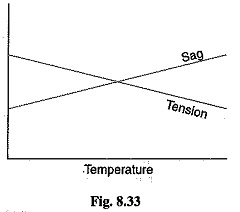Mechanical Principles in Transmission Lines:
Mechanical Principles in Transmission Lines design should depend to some extent on the importance of continuity of operation in the line under consideration. In general, the strength of the line should be such as to provide against the worst probable weather conditions. We now discuss some important points in the Mechanical Principles in Transmission Lines.
1.Tower height: Tower height depends upon the length of span. With long spans, relatively few towers are required but they must be tall and correspondingly costly. It is not usually possible to determine the tower height and span length on the basis of direct construction costs because the lightning hazards increase greatly as the height of the conductors above ground is increased. This is one reason that horizontal spacing is favoured inspite of the wider right of way required.
2.Conductor clearance to ground: The conductor clearance to ground at the time of great¬est sag should not be less than some specified distance (usually between 6 and 12 m), depending on the voltage, on the nature of the country and on the local laws. The greatest sag may occur on the hottest day of summer on account of the expansion of the wire or it may occur in winter owing to the formation of a heavy coating of ice on the wires. Special provisions must be made for melting ice from the power lines.
3.Sag and tension: When laying overhead transmission lines, it is necessary to allow a reasonable factor of safety in respect of the tension to which the conductor is subjected. The tension is governed by the effects of wind, ice loading and temperature variations. The relationship between tension and sag is dependent on the loading conditions and temperature variations. For example, the tension increases when the temperature decreases and there is a corresponding decrease in the sag. Icing-up of the line and wind loading will cause stretching of the conductor by an amount dependent on the line tension.
In planning the sag, tension and clearance to ground of a given span, a maximum stress is selected. It is then aimed to have this stress developed at the worst probable weather conditions (i.e. minimum expected temperature, maximum ice loading and maximum wind). Wind loading increases the sag in the direction of resultant loading but decreases the vertical component. Therefore, in clearance calculations, the effect of wind should not be included unless horizontal clearance is important.
4.Stringing charts: For use in the field work of stringing the conductors, temperature-sag and temperature-tension charts are plotted for the given conductor and loading conditions. Such curves are called stringing charts (see Fig. 8.33). These charts are very helpful while stringing overhead lines.
5.Conductor spacing: Spacing of conductors should be such so as to provide safety against flash-over when the wires are swinging in the wind. The proper spacing is a function of span length, voltage and weather conditions. The use of horizontal spacing eliminates the danger caused by unequal ice loading. Small wires or wires of light material are subjected to more swinging by the wind than heavy conductors. Therefore, light wires should be given greater spacing.
6.Conductor vibration: Wind exerts pressure on the exposed surface of the conductor. If the wind velocity is small, the swinging of conductors is harmless provided the clearance is sufficiently large so that conductors do not approach within the sparking distance of each other. A completely different type of vibration, called dancing, is caused by the action of fairly strong wind on a wire covered with ice, when the ice coating happens to take a form which makes a good air-foil section. Then the whole span may sail up like a kite until it reaches the limit of its slack, stops with a jerk and falls or sails back. The harmful effects of these vibrations occur at the clamps or supports where the conductor suffers fatigue and breaks eventually. In order to protect the conductors, dampers are used.
